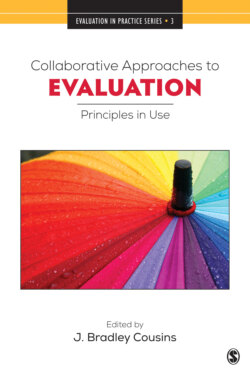Читать книгу Collaborative Approaches to Evaluation - Группа авторов - Страница 18
Why CAE? The Three P’s of CAE Justification
ОглавлениеFor some time, we have tried to capture justifications for CAE as being a blend of three specific categories: pragmatic, political, and philosophical (Cousins & Chouinard, 2012; Cousins, Donohue, & Bloom, 1996; Cousins & Whitmore, 1998). These categories, to our way of thinking, are not mutually exclusive; the justification for any CAE will draw from two or more of them depending on interests, and perhaps more importantly, whose interests are being served. Pragmatic interests driving CAE are all about leveraging change through the use of evaluative evidence, in other words, using evaluation for practical problem solving. Of primary concern would be instrumental (discrete decision-making about interventions) and conceptual (learning) uses of evaluation findings. Program community members working with evaluators learn about how to change programs to improve them or make them more effective. Historically, we have considered political interests driving CAE to be largely socio-political and focused on empowerment and the amelioration of social inequity. Through participation in the evaluation knowledge production function, intended program beneficiaries (often from marginalized populations) and other program community members learn to see their circumstances differently and to recognize oppressive forces at play. Such engagement may lead to the development of an ethos of self-determination. Finally, philosophic justifications for CAE are grounded in a quest for deeper understanding of the complexities associated with the program and the context within which it is operating. Through evaluators working hand-in-hand with program community members, the joint production of knowledge is grounded in historical, sociopolitical, economic, and educational context. Thanks to the insider insights of participating program community members, deeper meaning of evaluative evidence and knowledge is achieved.
As mentioned, these categories are understood not to be mutually exclusive, and as such, any given CAE will place relative emphasis on one or more depending on information needs, contextual exigencies, and circumstances. Cousins and Whitmore (1998) identified two principal streams of participatory evaluation as being practical and transformative. The former would emphasize the pragmatic justification, whereas the latter privileges the political justification; both streams, however, draw from all three justifications. For example, in practical participatory evaluation, program community members may find the experience to be rewarding in terms of their own professional development even though the primary purpose is to generate knowledge supporting program improvement. Such capacity building is an example of process use even though it is an unintended positive consequence of the evaluation. On the other hand, transformative participatory evaluation where empowerment and capacity building are central may also lead to positive changes to interventions as a result of evaluation findings. We observe that Fetterman and colleagues (Fetterman & Wandersman, 2005; Fetterman et al., 2018) have followed this lead in describing two streams of empowerment evaluation.
